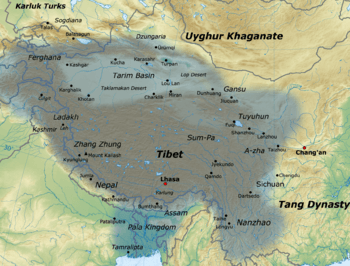Tubo facts for kids
Quick facts for kids
Tubo (吐蕃、大蕃国)
བོད་ཆེན་པོ།
Bod chen po |
|||||||||||||
|---|---|---|---|---|---|---|---|---|---|---|---|---|---|
| 618–842 | |||||||||||||
|
Flag of Tibet
|
|||||||||||||

Map of the Tibetan empire at its greatest extent between the 780s and the 790s
|
|||||||||||||
| Capital | Lhasa | ||||||||||||
| Common languages | Tibetan language | ||||||||||||
| Religion | Tibetan Buddhism, Bön | ||||||||||||
| Government | Monarchy | ||||||||||||
| Tsenpo (Emperor) | |||||||||||||
|
• 618–650
|
Songtsen Gampo (first) | ||||||||||||
|
• 756–797
|
Trisong Detsen | ||||||||||||
|
• 815–838
|
Ralpacan | ||||||||||||
| Lönchen (Chief Minister) | |||||||||||||
|
• 652–667
|
Gar Tongtsen Yülsung | ||||||||||||
|
• 685–699
|
Gar Trinring Tsendro | ||||||||||||
|
• 782?–783
|
Nganlam Takdra Lukhong | ||||||||||||
|
• 783–796
|
Nanam Shang Gyaltsen Lhanang | ||||||||||||
| Banchenpo (Chief Monk) | |||||||||||||
|
• 798–?
|
Nyang Tingngezin Sangpo (first) | ||||||||||||
|
• ?–838
|
Dranga Palkye Yongten (last) | ||||||||||||
| History | |||||||||||||
|
• Founded by Emperor Songtsen Gampo
|
618 | ||||||||||||
|
• Death of Langdarma
|
842 | ||||||||||||
| Area | |||||||||||||
| 800 est. | 4,600,000 km2 (1,800,000 sq mi) | ||||||||||||
|
|||||||||||||
| Today part of | China India Nepal Pakistan |
||||||||||||
The Tubo Empire, also known as the Tibetan Empire, was a powerful kingdom that existed from the 7th to the 9th centuries. It controlled a large area, including the Tibetan Plateau and parts of Central Asia and South Asia. This empire was very important in the history of Tibet.
Contents
Rise of the Tubo Empire
The Tubo Empire began in the year 618. Its first king was a strong leader named Songtsen Gampo. He united many smaller groups in the region to create one big empire.
King Songtsen Gampo's Rule
King Songtsen Gampo was a very important ruler. He helped create the Tibetan alphabet, which is still used today. He also played a big role in bringing Buddhism to Tibet.
Buddhism came from China and India. The Tubo people combined it with their own traditional religion, called Bön. This mix created a unique form of faith known as Tibetan Buddhism.
Expanding the Empire
After Songtsen Gampo, other kings like Mangsong Mangzan continued to expand the empire. The Tubo Empire became very large and powerful. It had a strong army and was able to control many different lands.
Culture and Religion
The Tubo Empire was a place where different cultures met. People from various regions lived under its rule. The empire's leaders encouraged the spread of Buddhism.
Tibetan Buddhism
Tibetan Buddhism became the main religion of the empire. Monasteries were built, and many people studied Buddhist teachings. This religion influenced art, music, and the daily lives of the people.
Language and Writing
The creation of the Tibetan alphabet was a major achievement. It allowed people to write down their history, religious texts, and laws. This helped to preserve their culture for future generations.
Decline of the Empire
The Tubo Empire lasted for about 200 years. It began to decline after the death of its last emperor, Langdarma, in 842. After his death, the empire broke into smaller parts. This period is known as the Era of Fragmentation.
Legacy of Tubo
Even though the Tubo Empire ended, its impact was long-lasting. It helped shape the culture, language, and religion of Tibet. Many traditions and beliefs from that time are still important in Tibet today.
See also
 In Spanish: Tubo para niños
In Spanish: Tubo para niños


